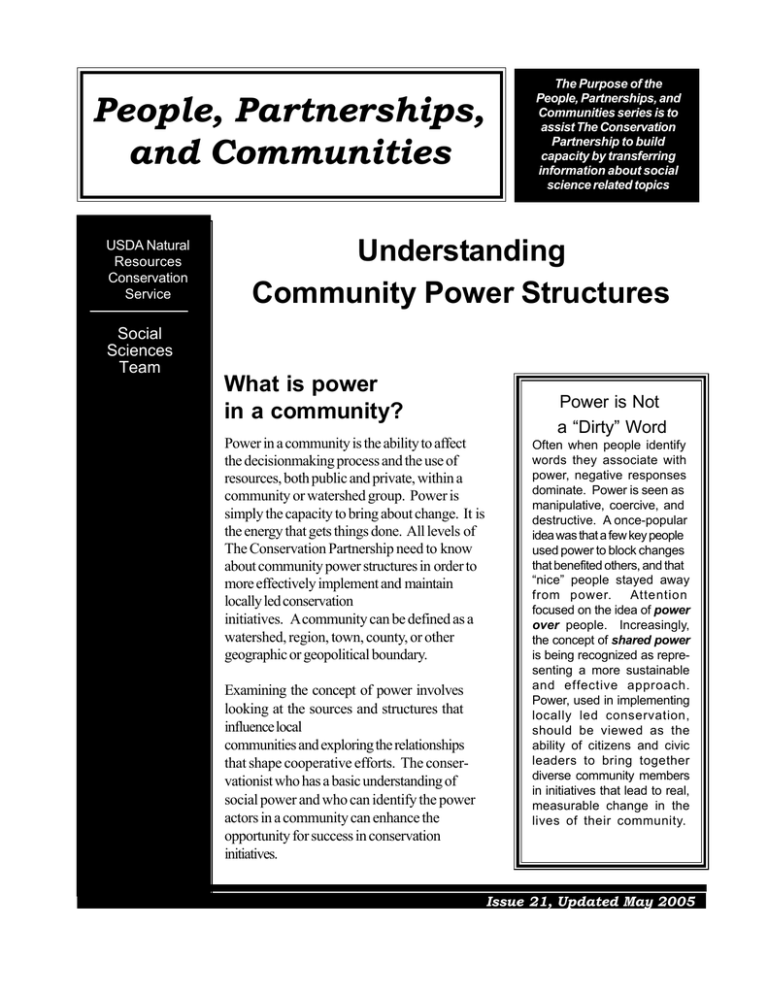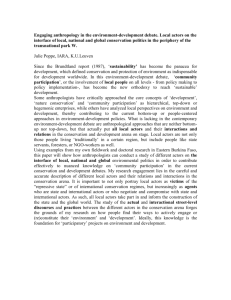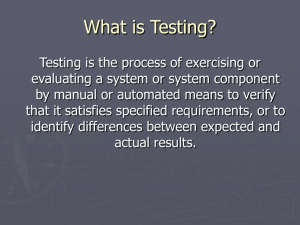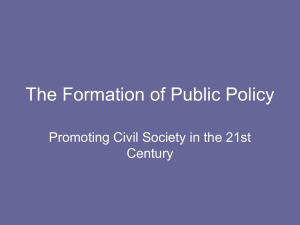People, Partnerships, and Communities
advertisement

People, Partnerships, and Communities USDA Natural Resources Conservation Service Social Sciences Team The Purpose of the People, Partnerships, and Communities series is to assist The Conservation Partnership to build capacity by transferring information about social science related topics Understanding Community Power Structures What is power in a community? Power in a community is the ability to affect the decisionmaking process and the use of resources, both public and private, within a community or watershed group. Power is simply the capacity to bring about change. It is the energy that gets things done. All levels of The Conservation Partnership need to know about community power structures in order to more effectively implement and maintain locally led conservation initiatives. A community can be defined as a watershed, region, town, county, or other geographic or geopolitical boundary. Examining the concept of power involves looking at the sources and structures that influence local communities and exploring the relationships that shape cooperative efforts. The conservationist who has a basic understanding of social power and who can identify the power actors in a community can enhance the opportunity for success in conservation initiatives. Power is Not a “Dirty” Word Often when people identify words they associate with power, negative responses dominate. Power is seen as manipulative, coercive, and destructive. A once-popular idea was that a few key people used power to block changes that benefited others, and that “nice” people stayed away from power. Attention focused on the idea of power over people. Increasingly, the concept of shared power is being recognized as representing a more sustainable and effective approach. Power, used in implementing locally led conservation, should be viewed as the ability of citizens and civic leaders to bring together diverse community members in initiatives that lead to real, measurable change in the lives of their community. Issue 21, Updated May 2005 Page 2 People, Partnerships, and Communities Why should you use this information? A conservationist’s ability to identify and understand the power structures in a watershed group or community and the relationships among the people that fortify them will significantly contribute to the achievement of conservation goals. As you encounter issues that routinely challenge organizations, agencies, communities, regions, or states, it is important to ask questions such as: • Who seems the most powerful in this situation and why? • What are the influences that might change the power structure in a group? • What type of power do you and others working with you bring to the situation? CONNECTIONS “Social networks have value – is the core idea of social capital theory. Just as a screwdriver (physical capital) or a college education (human capital) can increase productivity (both individual and collective), so too social contacts affect the productivity of individuals and groups. Whereas physical capital refers to physical objects and human capital refers to properties of individuals, social capital refers to connections among individuals – social networks and the norms of reciprocity and trustworthiness that arise from them. In that sense social capital is closely related to what some have called “civic virtue.” The difference is that “social capital” calls attention to the fact that civic virtue is most powerful when embedded in a dense network of reciprocal social relations. A society of many virtuous but isolated individuals is not necessarily rich in social capital.” Robert D. Putnam Bowling Alone, 2001 What are the sources of community power? Power can come from a variety of places. The following sources of power are not mutually exclusive and can be most effective when used in some combination. Conservationists who learn to recognize the power base(s) of a key leader or a community group can maximize the benefit that the power base can offer. a conservation initiative that meets their mission or priorities. • Personal traits - an individual’s charisma, creativity, charm, leadership abilities or some combination of these characteristics can foster the respect and loyalty of others. • Legitimate power - the position (office, title) of the leader. Usually, the higher the office, the more • Connections - the ability to network and build powerful the person. The city manager, for example, useful relationships with other powerful individuals holds a higher position and has more power than the and organizations. For example, occasionally one city engineer. Or, the chief of an American Indian hears the expression, “S/he’s really well connected. tribe has traditional and legitimate power. • Large numbers of people - provide evidence of • Expertise - knowledge, skill, and talent, combined support for an idea. A recent increase in memberwith respect for the skill. A district conservationist ship of a watershed group, for example, could have an can bring valuable skills to a conservation initiative. impact on a county commissioner. • Information - the ability to channel - or withhold • Rewards - the ability to give recognition, visibility, information. The mass media has this type of power. money, or other tangible items. For example, an • Coercion - the attempt to influence others using a agency, a community foundation, county commission, or negative style, such as using intimidation or manipulafinancially powerful individual or business may have tion. This contributed to the concept of power as a monies or other assets that can be distributed to “dirty word” and is now less accepted. Issue 21, Updated May 2005 People, Partnerships, and Communities Page 3 Who are the people with power? How do individuals get power in a community? Social systems of all types - communities, political parties, etc. - have certain people or groups of people who control decisionmaking functions. These people can be called key leaders of power actors. Authority is the power held by a person in an elected or appointed “office.” No matter who holds the office the authority is the same, unless the law changes. Presidents of the United States have had the same authority but have differed in their focus and their personal influence. Even the most distressed community has some business activity. In addition, there is a combination of public and nonprofit institutions such as schools, parks, libraries, police stations, social service agencies, community colleges, and hospitals. These groups can and do influence the changes made in the community. Power actors or key leaders are the individuals who direct these organizations, either formally or informally. Influence is the power that resides with an individual or an organization based on a person’s perception of their competence and ability. Their influence may be based on their skills in guiding and directing people, their specialized knowledge, their reputation, or their control of and/or access to money and resources (e.g., credit and jobs). Those with the most power in a community have that power primarily because of their influence, not just When community social action projects initiated by their positions of authority, so we must find ways to change agents (conservationists, public action groups, identify power actors that do not depend on titles and etc.) fail, it is often because they did not recognize offices alone. and/or appropriately involve key people in the community or the community at large. An individual In most communities, the following characteristics concerned with one segment of the community, such as are most often identified as a basis for influence and agriculture, may not know the key people in other power: segments of the community. The key people involved in community decisionmaking can vary depending on • past achievements • source of ideas • human the issue. relations skills • contact with others (in and outside of the community) • access to needed Key people–power actors–are aware of and value resources • influence within community organizatheir position. Most will work hard to keep it. They tions • past participation in community groups• length of residence in the community • occupation do this by either supporting or opposing projects • education • control of jobs, wealth, credit, and and by providing or denying resources. mass media The key leaders’ position often depends on: •What the proposal involves •When they were informed •How they were informed •Who informed them Control of credit or jobs may involve local businesses such as banks, manufacturing plants, and the media. Evidence suggests that the control of credit, money, jobs, and mass media is very important when combined with other bases of influence. Issue 21, Updated 2005 Page 4 People, Partnerships, and Communities What Is a Power Structure? A power structure in a community or watershed group is key leaders (power actors) acting together to affect what gets done and how it gets done. However, the nature of the relationships among the individual power actors can vary from one community to another. • Some communities have a power structure centered on one person who is surrounded by “lieutenants.” • Other communities have a small, tightly knit group – the power elite – that controls policy-making for the community. • Another structure is the “split community.” Examples include RepublicanDemocrat, Protestant-Catholic, liberal-conservative, labor-management, rural-urban, and others. • The “power pool” involves a combination of all three. Essentially, there is a “pool” of 10 to 25 people who are the top community power actors. • In some communities, tradition or elders are the powerful members. • Finally, some culturally diverse communities base their power almost totally on democratic principles and unanimity. The “power pool” may be the most common kind of power structure. The other structures are special cases found in communities with unique characteristics. The “power pool” has at least the following implications for conservationists and other change agents: 1. The same power actors may not be relevant to every issue, so each issue needs to identify appropriate power actors. 2. There are communication networks within the pool. A discussion with one or more power actors provides an indirect method for communicating a message to several other power actors. It also provides a means for communicating to other people in the community. 3. Members of the power pool change over time. In addition, the power of one individual relative to another may change, so the assessment of power actors cannot be viewed as a one-time task. Issue 21, Updated 2005 People, Partnerships, and Communities Page 5 What Are Informal and Formal Power Structures? There are two kinds of power structures: formal and informal. The formal power structure is easily recognized and includes elected and appointed government officials and leaders of civic organizations. The informal power structure, which exists together with the formal power structure, is harder to identify and may hold a greater influence over a community’s development. Four methods have been developed that will help conservationists identify the community’s formal and informal power structures. 1. Positional method - This method merely involves making a list of key government and civic leaders. It is a simple, but flawed, approach. It presumes that people in official positions actually execute power, and it does not recognize those power actors who work behind the scenes and operate on the base of personal influence. 2. Reputational method - Ask knowledgeable citizens to list the most influential people in the community or watershed. The same names should reappear on several lists. People to interview should include chamber of commerce executives, city managers, utility managers, media executives, economic developers, and business executives, among others. 3. Decisionmaking method – Study the history of community decisionmaking to determine the power actors who actively participate in community actions. Sources of information include meeting minutes, press reports, and participant interviews. It is possible to determine members of a general power structure using this method, and whether specialized power structures exist that deal with single issues. 4. Social Participation method - Develop a list of active participants (officers, committee chairs, etc.) in voluntary associations. This method assumes that activists in organizations will be the same people who are active in community decisionmaking. This method is useful when determining future community leaders who are working their way up through volunteer participation. For more information on identifying the key leaders in a community, refer to People, Partnerships, and Communities series, Issue 43, “Working With Community Leaders.” Issue 21, Updated 2005 Page 6 People, Partnerships, and Communities How Do You Put It to Work? Successful implementation of natural resource goals cannot succeed without the active participation of the community power structure. By working together, everyone can benefit. The following is a summary of the steps to take when assessing power structures and identifying key leaders in a community or watershed group. • • Identify the members of both the formal and the informal power structures • by power, such as power over resources? Money? Do they have a desire for recognition, such as wanting to run for public office or other high profile position? Do they have a strong sense of social responsibility? What causes are “hot buttons” for them? Find the important relationships. Which people are personal friends? Who are adversaries, competitors, or antagonists? Who can effectively influence others? • Determine the kind of power the key leaders exercise (refer to the “What are the sources of community power?” section). After determining what bases of power the leader uses, you can decide on an appropriate approach to take when working for or with them. • Establish trust and gain the confidence of key leaders. Maintain a focus on each other’s backgrounds, interests, values, and priorities. A climate of cooperation and trust is essential if a group expects the change process to sustain momentum. Issue 21, Updated May 2005 Learn what motivates each member of the power structure. Are they motivated • Ask leaders for their counsel and advice. Obtain the support of key leaders before pursuing a course of action. It will make your job easier and the project will have a better chance to be successful. • Do not back key leaders and power actors into a corner. Always provide a facesaving means for power actors to join with the initiative group despite any initial opposition they may have expressed. People, Partnerships, and Communities Page 7 Where to look for more information: o Chrislip, David D. “The Collaborative Leadership Fieldbook.” San Francisco: Joey-Bass Publishers, 2002. o Chrislip, David D., and Carl E. Larson. “Collaborative Leadership: How Citizens and Civic Leaders Can Make a Difference.” San Francisco: Joey-Bass Publishers, 1994. o Kretzmann, John, and John McKnight. “Building Communities from the Inside Out: A Path Towards Finding and Mobilizing A Community’s Assets.” Chicago: ACTA Publications, 1993. o Michigan State University, Michigan State University Extension, and USDA NRCS “Developing Your Skills to INVOLVE COMMUNITIES in Implementing Locally Led Conservation.” Module 5, Power in Communities. Grand Rapids, Michigan:, 1999. o Powers, Ronald C. “Identifying the Community Power Structure.” North Central Regional Extension, Publication 19. Ames, Iowa: Iowa State University of Science and Technology Cooperative Extension Service, November 1975. o Putnam, Robert D. “Bowling Alone.” New York: Simon and Schuster, 2001. o Shively, Robert W. “Community Power Structures.” Economic Development Review (Summer 1994): 13-15. o USDA-NRCS “People, Partnerships, and Communities.” Issue 43, Working With Community Leaders. Grand Rapids, Michigan: Social Sciences Institute, October 1999. o Tolbert, Charles et al. “Civic Community in Small-Town America: How Civic Welfare is Influenced by Local Capitalism and Civic Engagement.” Rural Sociology 67, no 1 (March 2002): 90-113. *** Issue 21, Updated May 2005 People, Partnerships, and Communities Page 8 Establishment The Natural Resources Conservation Service established the Social Sciences Team (SST) in September 2004 in order to more fully integrate the social sciences into Agency programs and activities. The goal is to more effectively serve our rural and urban customers and to increase adoption of conservation. Mission The Social Sciences Team integrates customer opinion and field work with science based analysis to discover how the social and economic aspects of human behavior can be applied to natural resource conservation programs, policies, and activities. Vision The Social Sciences Team will be a recognized leader in developing and transferring practical social sciences technology to assist in the productive, equitable, and environmentally sound use of our global natural resources. The U.S. Department of Agriculture (USDA) prohibits discrimination in all its programs and activities on the basis of race, color, national origin, age, disability, and where applicable, sex, marital status, familial status, parental status, religion, sexual orientation, genetic information, political beliefs, reprisal, or because all or a part of an individual’s income derived from any public assistance program. (Not all prohibited bases apply to all programs.) Persons with disabilities who require alternative means for communication of program information (Braille, large print, audiotape, etc.) should contact USDA's TARGET Center at (202) 720-2600 (voice and TDD). To file a complaint of discrimination, write to USDA, Director, Office of Civil Rights, 1400 Independence Avenue, SW, Washington, D.C. 20250-9410 or call (800) 795-3272 (voice) or (202) 720-6382 (TDD). USDA is an equal opportunity provider. Issue 21, September 2002




